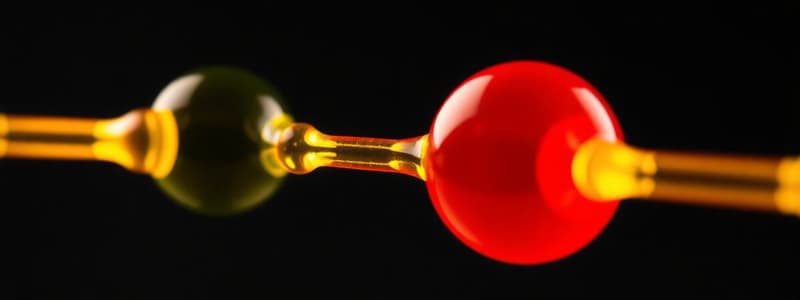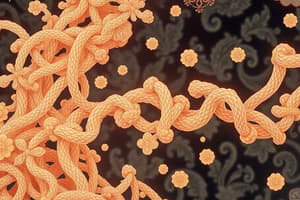Podcast
Questions and Answers
Which type of amino acid is arginine classified as?
Which type of amino acid is arginine classified as?
- Semi-essential (correct)
- Tertiary
- Essential
- Non-essential
What is the correct classification of a peptide consisting of three amino acids?
What is the correct classification of a peptide consisting of three amino acids?
- Polypeptide
- Tripeptide (correct)
- Oligopeptide
- Dipeptide
Which amino acid serves as the amino (N) terminal in the given peptide Val–Cys–Asp–Leu–Ala–Arg–Phe–Glu–Trp?
Which amino acid serves as the amino (N) terminal in the given peptide Val–Cys–Asp–Leu–Ala–Arg–Phe–Glu–Trp?
- Cys
- Leu
- Trp
- Val (correct)
Which of the following carbohydrate types is classified as a homopolysaccharide?
Which of the following carbohydrate types is classified as a homopolysaccharide?
Which amino acid is identified as the carboxyl (C) terminal in the peptide chain Val–Cys–Asp–Leu–Ala–Arg–Phe–Glu–Trp?
Which amino acid is identified as the carboxyl (C) terminal in the peptide chain Val–Cys–Asp–Leu–Ala–Arg–Phe–Glu–Trp?
What is a primary consequence of protein energy malnutrition due to lack of essential dietary requirements?
What is a primary consequence of protein energy malnutrition due to lack of essential dietary requirements?
Which mechanism describes how heat stroke can lead to brain damage?
Which mechanism describes how heat stroke can lead to brain damage?
What role does lowering body temperature play in organ cryopreservation?
What role does lowering body temperature play in organ cryopreservation?
How does penicillin affect bacterial cells?
How does penicillin affect bacterial cells?
What is the consequence of inappropriate activation of digestive enzymes in the pancreas?
What is the consequence of inappropriate activation of digestive enzymes in the pancreas?
What is the impact of organophosphorus compounds on the nervous system?
What is the impact of organophosphorus compounds on the nervous system?
How does carbon monoxide affect cellular respiration?
How does carbon monoxide affect cellular respiration?
What is the role of glutathione in the body?
What is the role of glutathione in the body?
What does a low Km value indicate about an enzyme's affinity for its substrate?
What does a low Km value indicate about an enzyme's affinity for its substrate?
Which of the following factors does NOT affect enzyme activity?
Which of the following factors does NOT affect enzyme activity?
What effect does bradykinin have on blood pressure?
What effect does bradykinin have on blood pressure?
Which mechanism leads to proto-oncogene activation through gene amplification?
Which mechanism leads to proto-oncogene activation through gene amplification?
What is the effect of marked changes in pH on enzyme activity?
What is the effect of marked changes in pH on enzyme activity?
Which of the following correctly describes the relationship between Km and Vmax?
Which of the following correctly describes the relationship between Km and Vmax?
How does vasopressin affect blood pressure?
How does vasopressin affect blood pressure?
The optimum pH range for most enzymes falls between which values?
The optimum pH range for most enzymes falls between which values?
Which amino acids are classified as polar uncharged?
Which amino acids are classified as polar uncharged?
What role do chaperones play in protein folding?
What role do chaperones play in protein folding?
Which amino acids are considered essential and must be supplied in the diet?
Which amino acids are considered essential and must be supplied in the diet?
Which group of amino acids contain sulfur in their side chains?
Which group of amino acids contain sulfur in their side chains?
How are ionic bonds formed in proteins?
How are ionic bonds formed in proteins?
Which amino acid is classified as an imino acid?
Which amino acid is classified as an imino acid?
Which enzyme is primarily associated with liver function and is important for diagnosing liver diseases?
Which enzyme is primarily associated with liver function and is important for diagnosing liver diseases?
What type of amino acid has side chains that cannot react with water?
What type of amino acid has side chains that cannot react with water?
What distinguishes isoenzymes from each other?
What distinguishes isoenzymes from each other?
Which amino acid is involved in the formation of covalent disulfide bonds?
Which amino acid is involved in the formation of covalent disulfide bonds?
What is the role of streptokinase in medical treatment?
What is the role of streptokinase in medical treatment?
What characteristic do aromatic amino acids share?
What characteristic do aromatic amino acids share?
Which of the following enzymes is associated with muscle damage?
Which of the following enzymes is associated with muscle damage?
Which type of amino acids are found on the surface of proteins and can react with water?
Which type of amino acids are found on the surface of proteins and can react with water?
Which enzyme is used therapeutically for patients with acute lymphoblastic leukemia?
Which enzyme is used therapeutically for patients with acute lymphoblastic leukemia?
Which enzyme can indicate both heart attacks and liver diseases?
Which enzyme can indicate both heart attacks and liver diseases?
Which isoenzyme is not associated with the brain?
Which isoenzyme is not associated with the brain?
What is the primary substrate that asparaginase acts upon?
What is the primary substrate that asparaginase acts upon?
Which enzyme is most commonly used to assess pancreatic disorders?
Which enzyme is most commonly used to assess pancreatic disorders?
Which factor does NOT typically influence the optimal conditions of isoenzymes?
Which factor does NOT typically influence the optimal conditions of isoenzymes?
Flashcards
Muscle atrophy in malnutrition
Muscle atrophy in malnutrition
Proteins and essential nutrients, like amino acids and fatty acids, are not consumed enough, leading to protein energy malnutrition.
Heat stroke
Heat stroke
High heat denatures proteins in the brain, disrupting cell function and communication. This can lead to organ damage and loss of consciousness.
Organ cryopreservation
Organ cryopreservation
Lowering body temperature slows down enzyme activity, minimizing metabolic processes and reducing tissue damage during organ preservation. This helps keep organs viable for transplantation.
Penicillin as an antibiotic
Penicillin as an antibiotic
Signup and view all the flashcards
Aspirin as an analgesic and antithrombotic
Aspirin as an analgesic and antithrombotic
Signup and view all the flashcards
Biochemical basis of pancreatitis
Biochemical basis of pancreatitis
Signup and view all the flashcards
Organophosphorus poisons
Organophosphorus poisons
Signup and view all the flashcards
Glutathione
Glutathione
Signup and view all the flashcards
Endorphin
Endorphin
Signup and view all the flashcards
Bradykinin
Bradykinin
Signup and view all the flashcards
Vasopressin
Vasopressin
Signup and view all the flashcards
Point mutation
Point mutation
Signup and view all the flashcards
Gene amplification
Gene amplification
Signup and view all the flashcards
Chromosomal translocation
Chromosomal translocation
Signup and view all the flashcards
Insertional mutagenesis
Insertional mutagenesis
Signup and view all the flashcards
Michaelis Constant (Km)
Michaelis Constant (Km)
Signup and view all the flashcards
What are amino acids?
What are amino acids?
Signup and view all the flashcards
What is a peptide bond?
What is a peptide bond?
Signup and view all the flashcards
What are the N-terminus and C-terminus of a peptide?
What are the N-terminus and C-terminus of a peptide?
Signup and view all the flashcards
What are monosaccharides?
What are monosaccharides?
Signup and view all the flashcards
What are disaccharides?
What are disaccharides?
Signup and view all the flashcards
Isoenzymes
Isoenzymes
Signup and view all the flashcards
Alkaline Phosphatase (ALP)
Alkaline Phosphatase (ALP)
Signup and view all the flashcards
Gamma-Glutamyl Transferase (GGT)
Gamma-Glutamyl Transferase (GGT)
Signup and view all the flashcards
Alanine Aminotransferase (ALT)
Alanine Aminotransferase (ALT)
Signup and view all the flashcards
Aspartate Aminotransferase (AST)
Aspartate Aminotransferase (AST)
Signup and view all the flashcards
Creatine Kinase (CK)
Creatine Kinase (CK)
Signup and view all the flashcards
Lactate Dehydrogenase (LDH)
Lactate Dehydrogenase (LDH)
Signup and view all the flashcards
Amylase & Lipase
Amylase & Lipase
Signup and view all the flashcards
Streptokinase
Streptokinase
Signup and view all the flashcards
Asparaginase
Asparaginase
Signup and view all the flashcards
What are Chaperones?
What are Chaperones?
Signup and view all the flashcards
What is Disulfide Isomerase?
What is Disulfide Isomerase?
Signup and view all the flashcards
What is Cis-Trans Isomerase?
What is Cis-Trans Isomerase?
Signup and view all the flashcards
What are Aliphatic Amino Acids?
What are Aliphatic Amino Acids?
Signup and view all the flashcards
What are Amino Acids with OH Groups?
What are Amino Acids with OH Groups?
Signup and view all the flashcards
What is Cysteine and its Role?
What is Cysteine and its Role?
Signup and view all the flashcards
What are Acidic Amino Acids?
What are Acidic Amino Acids?
Signup and view all the flashcards
What are Amide Derivatives?
What are Amide Derivatives?
Signup and view all the flashcards
What are Basic Amino Acids?
What are Basic Amino Acids?
Signup and view all the flashcards
What are Aromatic Amino Acids?
What are Aromatic Amino Acids?
Signup and view all the flashcards
Study Notes
Biochemical Aspects - Question 1 Comparison
-
Reversible - Competitive Inhibition: Inhibitor structure similar to substrate, binds to active site. E+I <-> EI. Km is increased, Vmax is not affected. Lineweaver-Burk plot: same y-intercept, x-intercept shifts left. Reversal by increasing substrate concentration. Examples include sulfonamides and methotrexate.
-
Reversible - Non-competitive Inhibition: Inhibitor structure not similar to substrate, binds to allosteric site. E+I <-> EI, ES+I <-> ESI. Vmax is decreased, Km is not affected. Lineweaver-Burk plot: same x-intercept, y-intercept shifts up. Reversal not by increasing substrate concentration, possibly by dialysis. Examples include dicumarol.
Michaelis-Menten Kinetics and Lineweaver-Burk Plots
- Michaelis-Menten kinetics describes enzyme-catalyzed reactions.
- Lineweaver-Burk plots are graphical representations of Michaelis-Menten data.
- The Lineweaver-Burk plot uses the reciprocal of the reaction rates.
- The y-intercept of the Lineweaver-Burk plot is 1/Vmax.
- The x-intercept of the Lineweaver-Burk plot is -1/Km.
- Competitive and non-competitive inhibitors shift the x and or y-intercepts of the lineweaver-burk plot differently
Other Concepts
-
Absolute Enzyme Specificity: Enzymes act on a single substrate. Example: glucokinase acts only on glucose, urease acts only on urea.
-
Relative Enzyme Specificity: Enzymes act on structurally similar substrates but not limited to one. Example: hexokinase acts on hexoses including glucose, fructose, mannose
-
Functional Plasma Enzymes: Enzymes in the blood with known functions, often synthesized by the liver to maintain health. Examples include clotting factors, lipoproteins.
-
Non-Functional Plasma Enzymes: Enzymes in the blood without known functions. Examples include ALT, AST, CK, LDH.
-
Enzyme Specificity: Each enzyme works optimally on a certain type of substrate, also known as either absolute or relative specificity
-
Glycogen and Starch: Both are branched polysaccharides with thousands of glucose units, important for glucose storage. Glycogen: in humans and animals. Starch: in plants.
-
Alcohol, Fats and Waxes: Alcohol: glycerol & fatty acid ester. Fats: ester of fatty acids and glycerol. Waxes: high molecular weight fatty acid and mono-hydroxyl alcohol
-
Protein Structure: The first structure, primary structure of a protein, is a linear sequence of amino acids. The secondary structure (secondary protein structure) is composed of alpha helices or beta sheets, while Tertiary structure (3D structure) is the three-dimensional shape formed by interactions between the secondary structures. The quaternary structure (quaternary protein structure) is the three dimensional shape formed by interactions between multiple polypeptide chains.
-
Enzyme Regulation Types: Short-term: Allosteric regulation, reversible covalent modification, proteolytic cleavage, and compartmentalization. Long-term: enzyme synthesis or degradation and enzyme compartmentalization
-
Monomers and Polymers: Monomers are small, single units, like glucose, amino acids, and nucleotides. Polymers are large molecules made up of repeating monomers, such as starch or proteins.
-
OH-containing and Sulfur-containing Amino Acids: OH-containing: serine, threonine. Sulfur-containing: cysteine, methionine
-
High & Low Biological Value Proteins: High biological value proteins (animal-based): contain all essential amino acids needed to build and maintain body proteins. Low biological Value proteins are plant-based (plant-based): deficient in one or more essential amino acids
-
PCR (Polymerase Chain Reaction): A technique to amplify DNA sequences from a small amount of DNA, useful for diagnosis of diseases.
-
Gene Cloning: A process to produce many copies of a DNA fragment.
-
Somatic and Germline Gene Therapy: Somatic gene therapy alters genes in non-reproductive cells and isn't passed on. Germline therapy alters genes in reproductive cells and can be inherited.
-
Cell Cycle Regulation: Regulation of cell growth and division: Strict regulatory mechanisms ensure balanced cell growth; however, deregulation is associated with several health problems such as uncontrolled cell growth in cancer
-
Enzyme Regulation: Long term: enzyme synthesis or degradation and enzyme compartmentalization. Short term: allosteric regulation, reversible covalent modification, proteolytic cleavage and compartmentalization.
Studying That Suits You
Use AI to generate personalized quizzes and flashcards to suit your learning preferences.
Related Documents
Description
Explore the biochemical principles behind reversible enzyme inhibition, focusing on competitive and non-competitive mechanisms. This quiz covers essential concepts such as Km, Vmax, and Lineweaver-Burk plots. Test your understanding of Michaelis-Menten kinetics and the implications for enzyme behavior.




